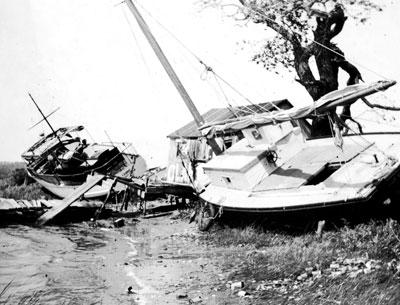The Day the Ocean Was in the Kitchen

“It had rained heavily for several days and then the morning sun came out on a lovely September day.” So begins the true story of a hurricane of unprecedented ferocity, one that caught residents of the East End by surprise on an afternoon 74 years ago tomorrow.
The account is mounted on a poster board that visitors see upon entering the East Hampton Historical Society’s Clinton Academy, where “The Long Island Express: Rare Photographs of East Hampton Town After the 1938 Hurricane” will be exhibited through Oct. 8.
The collection of 122 photographs depicts destruction on a scale that would otherwise be difficult to fathom. Huge trees completely uprooted, houses torn asunder, cars tossed this way and that — tidy villages rearranged in a matter of hours.
And while one East Hampton resident lost his life and many houses and commercial buildings were damaged or destroyed, the exhibit also depicts the coming together of a community in the aftermath of sudden devastation.
“It has its sad qualities, but is a part of the tapestry of life,” Richard Barons, the society’s executive director, remarked of the collection. “You can see [the hurricane’s] bonding qualities, the sense of survival, that ‘we will persevere.’ ”
The majority of the photographs are from the society’s own collection, which, Mr. Barons said, “grew by leaps and bounds by two collections that came to us within a year.” The troves to which he refers were taken by Earl Gardell, who lived in Amagansett, and Edward Jewett Jr., who lived in East Hampton. Peggy Sherrill, granddaughter of Mr. Gardell’s neighbor Herbert Edwards, donated the Gardell photos, while Mr. Jewett’s photographs were provided by his wife, Camilla, who has lived just three-tenths of a mile down Main Street from Clinton Academy for 63 years. The latter collection was discovered, among other photographs, in Ms. Jewett’s house last year.
Mr. Gardell’s photographs mostly depict downtown Amagansett and Beach Hampton, said Mr. Barons, while the Jewett collection includes East Hampton and Montauk. Mr. Jewett documented destruction at the Maidstone Club, where he was a member, and Montauk’s fishing village, then at Fort Pond Bay.
Mr. Barons took the original photographs, mostly two by three inches, to Reed’s Photo in East Hampton and Morris Studio in Southampton to be scanned and enlarged. “I always have them done in color,” he said of the black-and-white prints, “so you get the tonalities of what the original photograph looked like.”
Along with the enlarged prints hanging at Clinton Academy are glass cases in which the originals, along with other artifacts, are displayed. A blown-up print of page one of The Star’s Sept. 22, 1938, edition, devoted to the hurricane, is also on hand, as is a book in which visitors with firsthand knowledge have recorded their memories. This, said Mr. Barons, has spurred plans for a round-table discussion, to be held on Oct. 19 at the East Hampton Presbyterian Church’s Session House, at which witnesses will tell their stories. Other visitors, Mr. Barons added, have brought their own photographs to the society “for the next exhibition.”
As they were taken in the hurricane’s immediate aftermath, the photographs present an odd dichotomy of tranquillity amid a devastation that was probably unimaginable just two days earlier. When Mr. Jewett, a stockbroker working in Manhattan, learned of a hurricane battering East Hampton, where his parents lived, “he got in the car, but had a terrible time reaching here,” said Ms. Jewett, who is 101. “It was a disaster by the time he got to this end of the Island. There were trees down and all kinds of bad things to cope with.”
Ms. Jewett’s mother-in-law was the sculptor Maude Sherwood Jewett. She and her husband had lived on the ocean since around 1911, Ms. Jewett said, and did not evacuate. “They said the ocean was coming right through the kitchen.” Her father-in-law may have exaggerated, she allowed, “but he said fish and eels were coming through the kitchen!”
When Ms. Jewett came to East Hampton from New York City in 1939, the hurricane’s impact was still evident. “You could see where the trees were uprooted. Then the L.V.I.S. replaced most of them. They’re fully grown now, but I remember when a lot of them were planted,” she said.
The show has jogged memories, resulting in the aforementioned written recollections and visitors’ photos. There may be even more to come.
“I just went up to that drawer to see if I had more than I’d given to Richard,” Ms. Jewett told a visitor, “and I couldn’t get the drawer open — the thing sticks in summer, and the knob came off. I could probably find more, if I get that drawer open.”
